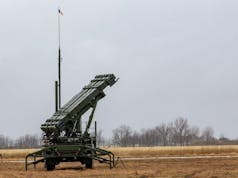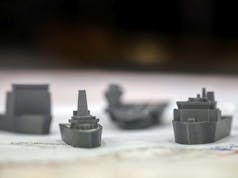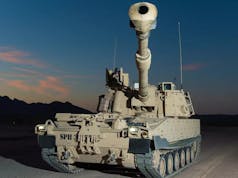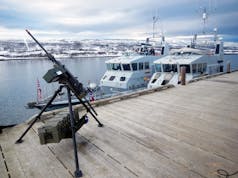The Russian ‘Bear’ strategic bomber was built by the Soviet Union during the height of the Cold War with the United States. Its initial design was based on the concept of a ‘Cold war Nuclear Bomber’.
Themilitary planners in the Soviet Union wanted to replicate the United States success of its strategic bomber force during the Second World War. This planned aircraft mission parameters were based on the ability to fly 5,000 miles to hit targets in the United States while also carrying twelve tons of bombs. However, as we shall see in this article the Russian Bear has become a symbolism of a resurgent Russia, testing and probing NATO defences, while delivering missile strikes upon rebel targets in Syria. It is still a force to be reckoned with.
Its national origin was the Soviet Union, and its manufacturer is Tupolev. Its first flight was the 12th November 1952, and was introduced to Soviet military service in 1956. It served with the Soviet Air Forces as well as the Soviet Navy, until the collapse of the Soviet Union. Since then, it has been operated by the Russian air force. One of the most revealing features of this bomber is its predicted longevity, as it’s expected to serve the Russian air force until at least 2040. This is incredible and shows how both its design and function as a military bomber is timeless.
This was by no means a small engineering feet, and the jet engines of the time burned out too quickly, which have new life to the propeller design. This design of a propeller pain with the ability to carry a heavy payload paid off. It was one of the fastest propeller planes in existence going at a speed of over 500 miles per hour.
Interesting quote by the National Interest (2016) says as follows:
“The tips of its eighteen-foot diameter propellers actually spin at slightly over the speed of sound. The Bear is also one of very few propeller plans with swept – back wings, which only benefit aircraft at high speed. The TU-95 also had tremendous fuel capacity and could fly over nine thousand miles just using internal fuel”.
In terms of a routine Cold war bomber patrol fight, it would last ten hours, but for the Russian ‘bear’ propeller bomber it would last twice as long. The crew consisted of two pilots, and two navigators, with a crew that operated the guns and sensory systems. However, the increasingly advances in military aircraft design rendered most bomber machine guns useless, and later variants would have only the tail gun. While the original design schematics for the Russian ‘Bear’ had two twin barrel 23mm cannons in the belly and tail and a fixed gun in the nose. This was to act as a deterrence to any belligerence in the air.
However, on a side note it is a mistake to believe the tail gun was redundant in an era of the jet engine. During the Vietnam War, non – commissioned officers USAF operated the tail guns recorded enemy aircraft shot down with either two or three kills against the North Vietnamese Airforce.
The simple concept of the Russian bear meant it was to be used as a nuclear strike delivery aircraft. It would fly over the artic and drop nuclear bombs on targets in the United States. While the Russian ‘bear’ may be vulnerable to either anti-aircraft missiles or air to air missiles, the understanding was that some of the bombers would get through and deliver a crippling blow to mainland United States.
However, nuclear strategic thinking shifted, and the Soviet Union considered a first strike weapon to be housed in faster bombers as well as submarines. Therefore the new TU-95 had a different mission profile.
According to The National Interest (2016) article. The TU-95 was refitted for the following purposes:
- In an attempt to address the vulnerability of the Russian bear bomber, it became a platform for long-range cruise missiles.
- The new TU-95ks would carry the KH-20 nuclear missile.
- The KU-20 missile would have a range of 300 to 600 miles.
- The Russian Bear would be used to shadow US Navy aircraft carrier battlegroups.
In addition, if there was an armed conflict between the United States and the Soviet Union the Soviet ‘bear’ bomber would launch a salvo of missiles which was designed to destroy US Navy ships and in particular carrier groups. In an actual war situation, the Soviet ‘Bear’ bomber would launch a crippling blow of numerous missiles to knock out the key capital ship, namely the aircraft carrier. Furthermore, the Bear’s ability to travel long distances means it could track enemy fleet movements and work within a squadron.
After the Cold War, and the collapse of the Soviet Union, the West and NATO did not see Russia as a military threat. However, with the election of Putin, he re-initiated Russian ‘Bear’ patrols which would test the air defences of NATO countries by using the bombers to fly really close to their airspace and thereby alerting their radar systems. This is still going on even today, and this in itself is symbolic of how we are creeping back to another Cold War.
It is worth remembering that of all the TU-95 bombers currently in service, are the Tu-95MS variant which was built in the 1980s and 1990s.
Politically, as a sign of a Russia aspiring to once again achieve its once lost status as a Great Power, President Putin announced the Tu-95 would fly patrols – 15 years since they ended. In addition during the Russian military exercise of Oct 2008, the Tu-95MS fired air launched cruise missiles for the first time since the days of the Cold War, when tensions were at its peak in 1984. The combination of missile technology and the durability of the Tu-95 design means it can continue to function as a strategic missile bomber for many years to come right into the 21st century. Its longevity can be comparable to that of the USAF B-52 bombers.
For those who are interested in aircraft design, this is emblematic of how a design can stand up to the test of time. If there is one aircraft the Tu-95 could be compared to, I would say it would be the United States Airforce B52 bomber. This United States bomber is also predicted to see service into the 2040s (Wired, 2016). Furthermore, with fiscal challenges as well as its durability in design could mean that the B52 could we serve into the 2050s and become the first 100 year old bomber. Coincidentally, the Tu-95 was also created in 1952. What is even more fascinating is that in Russia’s air force inventory there are a fleet of bombers which can exceed the speed of the ‘Bear’ bomber, as well as deliver larger payload to its targets. However, this does not mean that this particular workhorse of the once Soviet now Russian airforce is going to pack up anytime soon. Now we turn to Syria.
During the Russian intervention in the Syrian campaign was the first time it actually saw combat as a bomber (The National Interest, 2017). At the fall of 2015, The Russian government was proud to show the plane launching cruise missiles which went onto destroy the positions of Syrian rebels. It was the first time this bomber performed counter-insurgency operations and delivered a knockout blow from the air, with an impressive display of airpower.
To summarise, the Tu-95 still has the potential to strike fear, and also admiration for those who have respect for an aircraft which has spent so long in service, and in a digital age still can perform a valuable function as a strategic bomber. Its new purpose is to serve the Russian national interest, and to provide a ‘deterrence’ in the form of travelling and probing NATO airspace while also carrying out counter-terrorism operations in Syria by bombing rebel targets. It operates within range of three continents, in Europe, Asia and North America, and tests out air-defence systems. While it is predicted this will stay in service for years to come, its mission profile and adaptability means it is expected to continue into service until 2040, I personally predict this would be extended into the 2050s and beyond.
References:
Wired, (2016). ‘How on Gods Green Earth is the B-52 still in service’, [Online] Available from: https://www.wired.com/2016/04/gods-green-earth-b-52-still-service/
The National Interest. (2016). ‘The Tu-95: Russia Has Its Very Own B-52 Bomber’, [Online] available from: http://nationalinterest.org/feature/the-tu-95-bear-russia-has-its-very-own-b-52-bomber-17571
The National Interest. (2017). ‘Russia’s Tu-95 Bear Bomber: Everything You Need to Know’, [Online] Available from: http://nationalinterest.org/blog/the-buzz/russias-tu-95-bear-bomber-everything-you-need-know-20484



















Just for the info the B52 is actually older than the TU95 As is the TU16 which as the H6 is still flying as the main Chinese bomber.
You can imagine the outrage on here if Britain still operated an aircraft of this nature. Judgement seems to be flexible depending upon who is operating said item of interest as no doubt we shall see below.
Well said spyinthesky outrage seems to be the default position amongst some upon here !
I wonder how much money would have been saved if we’d bought half the number of Tornadoes and Jaguars and stuck with upgrading the Victors and Vulcans and the Canberras for that matter. They would have been ideal for lottering over Afghanistan, Libya etc… cheap… not sexy but more than able to do the job. With modern upgrades a Victor with a crew of 2 or 3 could have done the job of a half a squadron of Tornadoes. I guess the British taxpayer has the MoD, the RAF and of course sadly probably a lot of brown envelopes to… Read more »
Yeah, let’s not bother with anything designed after the 50s ? I trust you were being tongue in cheek Ali…Hard to tell sometimes with some people on here….
A factor to consider is that, while the US has a huge defence industry and the budget to allow it to thrive, and Russian defence is largely nationalised, our own industry has severely declined post-WWII. In order to support whats left of it, replacements for otherwise serviceable equipment are procured just to keep British companies afloat. The most recent example that comes to mind is pressure on the MoD to buy new Hawk jets for the Red Arrows just to keep the production lines in the UK open
Under the US civil and criminal code there are several laws to protect the Defense Industries. Most notably the Jones Act, Buy American Act 1933 , the Berry Amendment, and the Balance of Payments Act (base construction). Affected DoD procurements: Arms, ammunition or war materials. Purchases indispensable for national security. Sole-source acquisitions. Small business set-aside contracts. These bind the DoD to buy American built equipment or force foreign companies to build factories and shipyards in the US. The only exemption that is used is a “urgent operational requirement” (UOR). The penalties for a company found to have been… Read more »
Callum, another reason for the new buy of Hawks is the type of flying the Red Arrows do. It adds massively to the fatigue index of the aircraft, as they are sustaining +4.5g constantly. This significantly decreases the life of the airframe, and you can only rotate so many through the flight schools before you start running out of frames that can conduct flight displays. Of late the flight displays the “Reds” have been doing have been toned down due to this.
Too often people think they wear the fur of the Russian bear whilst in reality he’s still roaming the forest.
Last B52 was built in 1962, the last ‘Bear’ in 1994.
The illiteracy in this piece is unbelievable. Spelling errors, typos, undecipherable sentences…what does this sentnce even mean: “During the Vietnam War, non – commissioned officers USAF operated the tail guns recorded enemy aircraft shot down with either two or three kills against the North Vietnamese Airforce.”? How are we supposed to trust anything this journal says when it’s written with these writing standards? Proof-read your pieces, as a bare minimum!!
Fancy a job as a proof-reader?
As a dyslexic person I always need a proof reader.
It really is quite poor. It’s not just the spelling and grammar (both of which should be picked up by a basic spellcheck), the syntax often makes the author’s meaning difficult to understand and much of the technical language is used incorrectly. The inaccuracies aren’t even consistent; sometimes different versions of the name or close but incorrect synonyms are used in the same sentence. Ultimately it makes the article difficult to read as well as looking amateurish – more like the sort of thing you’d get on an enthusiastic teenager’s blog than a serious website.
Ali, you don’t think Victors and Vulcans are sexy aircraft?
Morning
Just goes to show, new is not always best.
Other platforms that have stood the test of time:
Hercules
Chinook
Hawk
F-15
If something is not broken – don’t try and fix it.
TU-95 can launch stand off cruise missiles 250 miles away from target. QRA will still be trundling down the runway.
Food for thought
Morning all
Yes I would have been pleased if the RAF had kept a squadron of Vulcan.
Canberra PR9 was our version of the TR1, that lasted longer.
The RAF still aspire to have a strategic bomber, just there’s no money. But more importantly the Airforce is in desperate need for a dedicated Counter Insurgency/Close Air Support aircraft. Something that has a long loiter time, large weapon load and cheap. This is because current operations such as Northern Iraq/Syria have significantly eaten in to the airframe lives of both Tornado and Typhoon. Yes, the Tu95 can release stand-off weapons from 300 miles away. However, they have a massive Radar Cross Section (RCS) and will be detected either by AWACs or ground/ship based radar a long time before they… Read more »
From an aesthetic point of view I always preferred the Victor and it had the advantages that you mention, but once the RAF had to go ‘down among the weeds’ to penetrate a sophisticated air defence system its airframe couldn’t handle the stresses low flying would put on it, unlike the Vulcan (which was also a fine plane).
Morning
Whilst the RAF May desperately need a COIN aircraft they will never accept anything unless it is a high end fast jet.
RAF have plenty of Tucano aircraft for example that could have been converted to carry weapons.
However, I am sure they would talk about time to target etc and how with fast air it they can be more flexible.
All the services are going through difficult changes at the moment, adapting to the money available against the requirements- it is whether they are willing to sacrifice fast air for slower, less adaptable platforms.